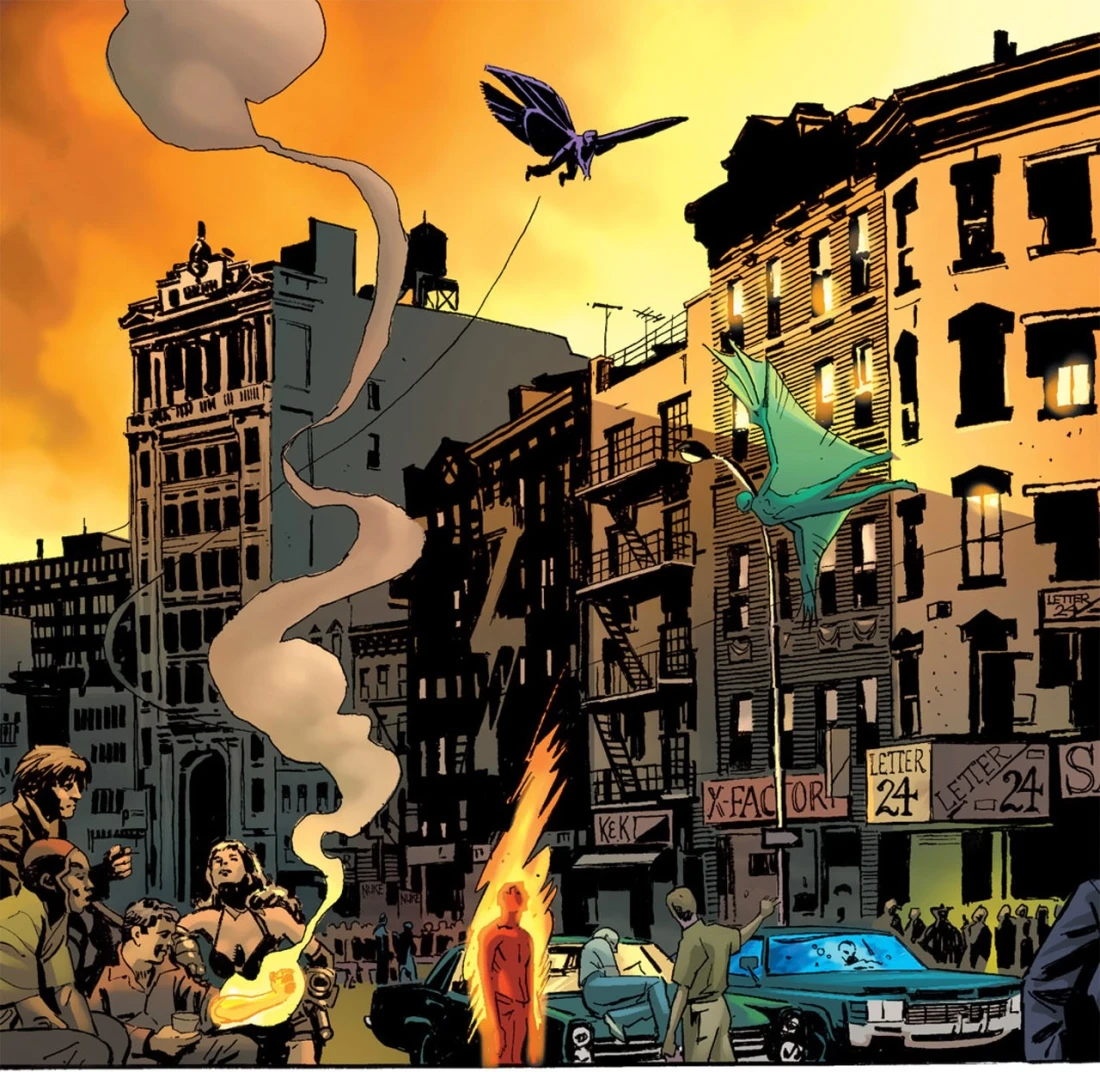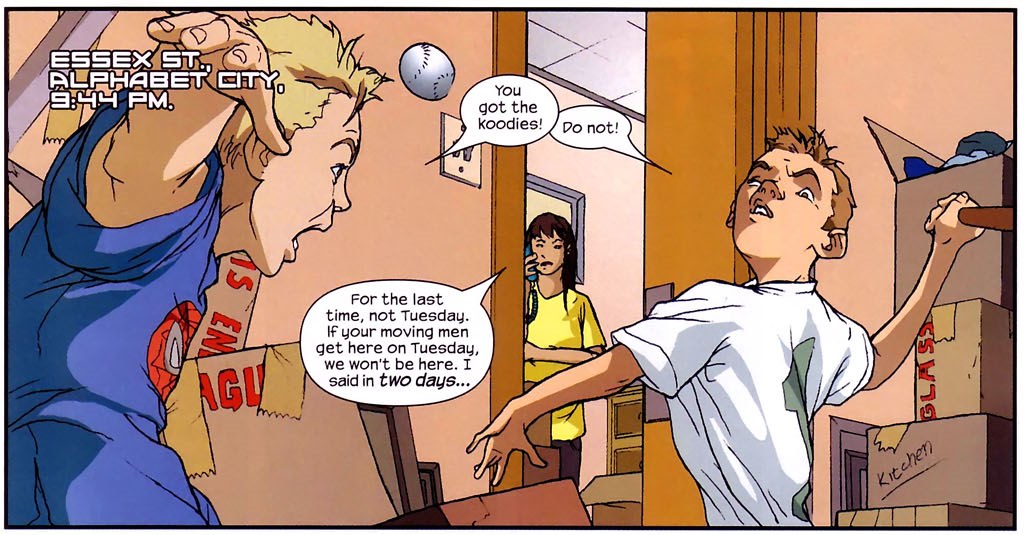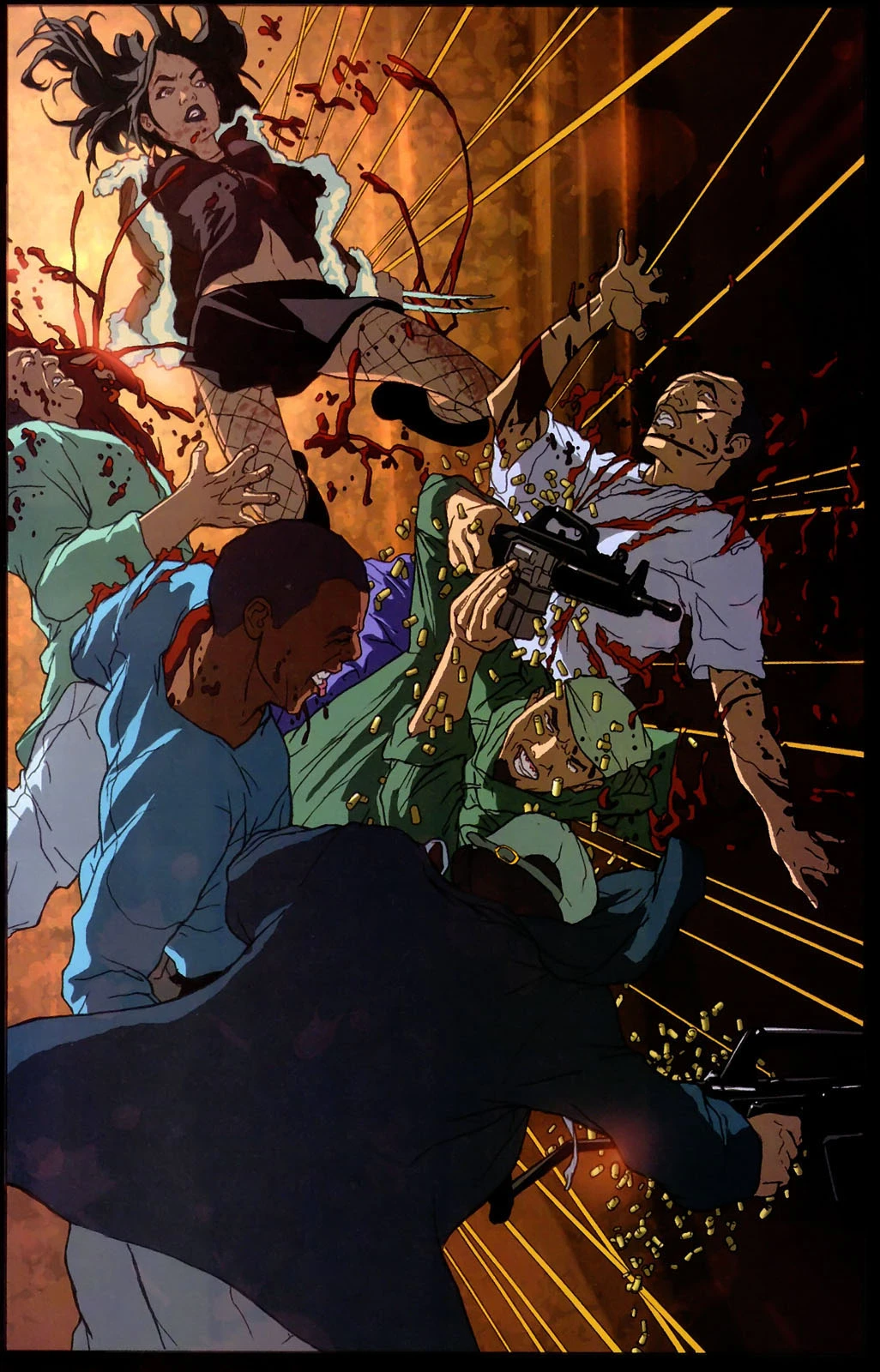This is the first of a series of posts dealing with Marvel’s New York mutant enclave, known variously as “Mutant Town” and “District X.” Throughout its lifetime of roughly six years, the neighborhood saw many changes in its meaning and configuration.
It first appeared in Grant Morrison and John Paul Leon’s New X-Men #127 (August 2002), as rumors of a monster lead to fearful protests against mutants in New York. After an establishing shot of the mutant-filled streets (see below), the scene cuts to two police officers on a barricade: “Go through it again, Dan,” one of them says, “we got the gays in one part of town, the poets in the other and the anarchists here and the copy editors there. Now we got militant mutants setting up flags in Alphabet City. What happened to the nice, quiet Melting Pot they promised me?”
This, especially when read in connection with an earlier scene set in Chinatown, marks the neighborhood as an enclave. This aspect of “Mutant Town” has been positively remarked by fandom: “Morrison turned mutants into a subculture […] He gave them their own Chinatown, their own Little Italy, and made it a point to show that mutants […] were more than just mutant paramilitary teams.” This might have been true for Morrison’s brief glimpse into “Mutant Town”; it was, as far as the sparse visuals suggest, a densely populated genetic enclave peopled by a diverse community of mutants. But that figuration did not hold for long.

Starting in October 2003, “District X” showed up again, in the seven-issue miniseries NYX (November 2003–October 2005), scripted by Joe Quesada and with art by Joshua Middleton (#1-4) and Robert Teranishi (#5-7). The series was hyped in a November 2003 New York Times article that praised Quesada and went a little overboard with its descriptions of comics’ supposed New York origins. About the series, the reporter wrote that it “takes place in Alphabet City and draws deeply on his [Quesada’s] city roots. It made its debut last month to strong reviews in the fan press.” Quesada himself added that “‘[w]ith comic books, you look at real-life situations and try to find the right metaphor,’ […] You ask yourself, ‘What if we took the world of the X-Men and shrunk it down?’ What if your concern was, ‘When am I going to eat next,’ even if you do have superpowers?”
The main character of NYX is Kiden Nixon, a rebellious teenager who witnessed her father, a policeman, gunned down by a criminal when she was a child. Her attitude problems get her into a fight with another kid at school, which leads him to bring a gun and try to shoot her. Using her newly manifested mutant powers, Kiden stops time and dodges the bullet, which instead hits Cameron Palmer, one of her teachers. Kiden runs away for six months and returns just in time to find Cameron attempting to kill herself. Kiden manages to save her teacher and spends time with her as she recovers. One night, Kiden wakes up suddenly, scribbles a hotel name and room number on a piece of paper, and storms out of the house. Cameron follows, seeing traces of her destination on the pad. They arrive at the hotel to find a young girl, a prostitute whom readers have been introduced to earlier in the issue, sitting on a bed with metal claws extending from her hands and a dead, abusive john on the floor.
From there, things escalate quickly. The girl’s pimp tries to find her and her new companions, which includes destroying Cameron’s apartment in a blaze of gunfire. Meanwhile, the girls are joined by another newly manifested mutant and scrounge their way through the city for a while before a showdown with the pimp takes place. Wrapping things up nicely, it turns out in the final issue that the pimp is also the man who shot Kiden’s father.
I do not find NYX particularly noteworthy. The story seems half-finished and there are a few things that are poorly explained and seem added only to push the narrative forward in an inorganic way. And the visuals do not really do anything for me. While the graphic style is clean and the artwork skillfully drawn, it does not fit the dirty tone that the story tries to establish. Rather, the series serves more than anything to illustrate how the evocation of the “New York-comics relationship” in connection with Marvel’s comics is often rhetorical gesturing. Quesada says that using New York as setting “grounds the fantasy […] We don’t have Metropolis. We don’t have Gotham City. It’s important to us to keep the real world real. The idea that that guy is jumping off the precipice of the Chrysler Building makes it that much more exciting. In any book I’ve ever done, the city has been a character.” That last statement might be true for NYX, given that the city as it appears in the series is about as well-defined as the flat cast of characters. But the emphasis is on “tell,” rather than “show”: NYX is spatially confused, both in terms of continuity and New York geography. Here, “District X” is located on the Lower East Side (#7 explicitly places Mulberry Street in the neighborhood) rather than in Morrison’s (and, as we’ll see later, David Hine’s stereotyped) Alphabet City, and Essex Street, also on the Lower East Side, somehow gets incorporated into Alphabet City.
 Quesada’s questions quoted above are certainly interesting, and for a while, NYX seems to promise to deliver. But a few issues in, the story goes Hollywood, leaving realism far behind. Reading NYX, one wonders where Quesada’s “grounding” is: is it in the idea that a pimp would storm an unknown apartment with thugs armed like a small army to get one of his girls back; or is it in the visions Kiden has, where her father appears to guide her; or is it when one of the girls gets shot at point-blank range with a machine gun only to heal almost instantly? By the final issue, instead of dumpster diving (of which, it must be granted, there is some in the series), we get the picture below. The mutants in NYX might not wear the uniforms carried by the X-Men, but at the end of their run, their story comes far closer to one of Xavier’s teams’ than to the girls asking where their next meal will come from.
Quesada’s questions quoted above are certainly interesting, and for a while, NYX seems to promise to deliver. But a few issues in, the story goes Hollywood, leaving realism far behind. Reading NYX, one wonders where Quesada’s “grounding” is: is it in the idea that a pimp would storm an unknown apartment with thugs armed like a small army to get one of his girls back; or is it in the visions Kiden has, where her father appears to guide her; or is it when one of the girls gets shot at point-blank range with a machine gun only to heal almost instantly? By the final issue, instead of dumpster diving (of which, it must be granted, there is some in the series), we get the picture below. The mutants in NYX might not wear the uniforms carried by the X-Men, but at the end of their run, their story comes far closer to one of Xavier’s teams’ than to the girls asking where their next meal will come from.
